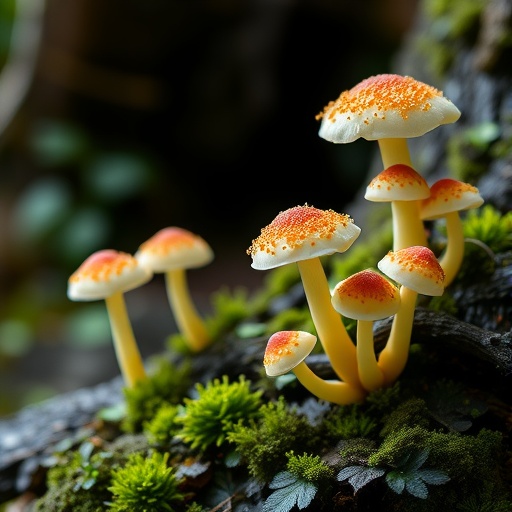In a groundbreaking study set to reshape our understanding of fungal symbiosis, researchers led by Cole J. and colleagues have unveiled a detailed genomic analysis of a metagenome-assembled genome from a rare Mucoromycotina fine root endophyte. This research brings to light the intricate mechanisms and distinctive symbiotic traits exhibited by arbuscular mycorrhizal fungi, organisms that occupy a crucial niche in soil health and plant nutrient acquisition. Their work, published in BMC Genomics, emphasizes the invaluable role these fungi play in ecological systems and agriculture, asserting the need for further research into their capabilities.
The study focuses on Mucoromycotina fungi, a group previously underestimated in terms of their ecological importance. Unlike more commonly studied fungal families, these organisms are often overlooked in metagenomic surveys despite their vital functions in soil ecosystems. The researchers employed advanced metagenomic methods to assemble the genome of the fungus, revealing a wealth of genetic data that provides insight into its symbiotic behavior.
The analysis showed that Mucoromycotina fungi possess a unique set of genes that facilitate their interaction with plant roots, enabling them to establish symbiotic relationships. This gene set includes those responsible for the synthesis of bioactive compounds that may influence plant growth and health. The discovery of these particular genes opens up new avenues for exploration regarding how this fungus can enhance nutrient uptake in plants, potentially leading to more sustainable agricultural practices.
Examining the genetic architecture of the fungal genome revealed not only its symbiotic traits but also its evolutionary adaptations. Researchers found that certain genetic sequences indicative of horizontal gene transfer, a phenomenon where organisms acquire genes from other species, were prevalent. This suggests a complex history of interaction between the fungus and other organisms in its environment, hinting at the dynamic nature of microbial communities and their evolutionary pathways.
The researchers also highlighted the role of enzyme production in the symbiotic relationship between the Mucoromycotina fine root endophyte and its host plants. Enzymes that degrade plant cell walls, for example, enable the fungus to infiltrate root structures more effectively, thereby enhancing its nutrient absorption capabilities. This ability to break down complex plant materials is critical to establishing a lasting relationship that benefits both the fungus and its plant partners.
Moreover, the study’s findings emphasize the ecological significance of these Mucoromycotina fungi. In ecosystems characterized by nutrient-poor soils, where many plants struggle to thrive, the presence of such fungi can make a significant difference. Their symbiotic relationships may allow plants to access essential nutrients such as phosphorus and nitrogen, thereby promoting plant growth and resilience in challenging environments. This interaction underlines the importance of preserving biodiversity within fungal communities, as their disappearance could have cascading effects on entire ecosystems.
As food security becomes an increasingly pressing global issue, understanding the mechanisms by which arbuscular mycorrhizal fungi enhance crop productivity is vital. Given the distinct genetic features of the Mucoromycotina fine root endophyte identified in this study, the potential for biotechnological applications is immense. By harnessing these fungi’s capabilities, agricultural scientists may develop innovative strategies to improve crop yields sustainably and reduce reliance on chemical fertilizers.
Additionally, the research reinforces the necessity for interdisciplinary approaches in studying fungal biology. The merging of genomic techniques with field-based observations can yield richer data sets that provide deeper insights into ecological interactions. This integrative methodology can lead to a more holistic understanding of how fungi impact plant health, soil systems, and overall ecological balance.
The implications of this research extend beyond agriculture and into the realms of environmental sustainability and conservation. By elucidating the genetic mechanisms of symbiotic relationships in fungi, researchers can better understand how to manage and enhance these networks within natural ecosystems. Protecting these vital organisms can contribute to soil health, carbon sequestration, and biodiversity conservation efforts around the globe.
Furthermore, the study presents an opportunity to advance our understanding of the evolutionary history of fungi. The genomic data derived from the Mucoromycotina fine root endophyte provides a reference point for future comparative studies, allowing researchers to explore the diversity of fungal genomes across different ecosystems and evolutionary contexts. As genomics continues to evolve as a tool for biological discovery, the template set by this research will pave the way for a new era of fungal biology.
In conclusion, Cole and colleagues’ study marks a significant step forward in the exploration of fungal genomics and symbiosis. The identification of unique genetic traits in the Mucoromycotina fine root endophyte not only advances our understanding of these fungi’s roles in ecosystem health but also opens up exciting possibilities for agricultural innovations. As the world faces growing environmental challenges, the revelations from this research underscore the importance of studying fungal biology, advocating for the preservation of microbial diversity, and exploring ways to leverage these organisms for sustainable agriculture.
Continued research in this field is paramount for both scientists and policy-makers aiming to address the multifaceted challenges posed by climate change, soil degradation, and global food security. As we deepen our understanding of the connections between soil microbiomes and plant health, the potential to transform agricultural practices and enhance ecological resilience becomes increasingly achievable.
By embracing the complexity of these relationships and fostering a greater appreciation for the fungal kingdom, we can work towards unlocking the secrets of nature that hold the promise for a more sustainable future.
Subject of Research: Comparative genomic analysis of Mucoromycotina fungi
Article Title: Comparative genomic analysis of a metagenome-assembled genome reveals distinctive symbiotic traits in a Mucoromycotina fine root endophyte arbuscular mycorrhizal fungus
Article References:
Cole, J., Raguideau, S., Abbaszadeh-Dahaji, P. et al. Comparative genomic analysis of a metagenome-assembled genome reveals distinctive symbiotic traits in a Mucoromycotina fine root endophyte arbuscular mycorrhizal fungus. BMC Genomics 26, 967 (2025). https://doi.org/10.1186/s12864-025-12149-w
Image Credits: AI Generated
DOI:
Keywords: Mucoromycotina, arbuscular mycorrhizal fungi, metagenomic analysis, symbiotic relationships, plant health, soil ecosystems, genetic diversity, sustainable agriculture.




